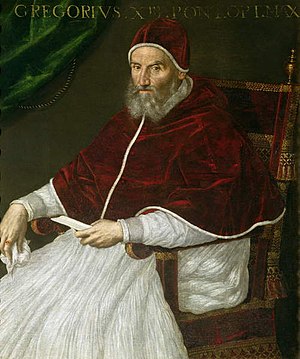 Image via Wikipedia
Image via WikipediaThe tropical year of 365 days, five hours, 48 minutes and 46 seconds is the time it takes the earth to circulate around the sun. The astronomer, Sosigenes, advised Julius Caesar to adopt a new calendar, in 46 BC, as an attempt to align the calendar with the tropical year. The new calendar, known as the Julian calendar, eventually was found to have some limitations. It was eleven minutes too long each year. By the sixteenth century, ten extra days had accumulated. Pope Gregory XIII was concerned that the calculated date of Easter by the Julian calendar had become incorrect. Christians believed that the date of the resurrection of Jesus Christ was the most important observance of the year. Therefore, upon the advice of the astronomer Clavius, Pope Gregory ordered the calendar to be revised, by papal bull. The Gregorian reform removed ten days from October 1582, and adjusted the leap year schedule to keep things on an even keel. The year 2008 will be a leap year.
The Catholic countries adopted the Gregorian calendar immediately. Because the Church of England was the official religion of England, its leaders were not inclined to follow Pope Gregory’s new calendar. However, by the mid-18th century, England (and her colonies) could no longer avoid the transition. Finally in 1751, the British Parliament passed the "Act for Regulating the Commencement of the Year; and for Correcting the Calendar now in Use" to join the rest of Europe, in using the Gregorian calendar. To fall in line with the correct date, Parliament degreed that eleven days needed to be eliminated. They omitted the days from September 3rd to 13th 1752. Parliament specified these dates as they avoided conflict with any major festivals in Britain.
A painting by William Hogarth, in 1755; titled "An Election Entertainment", shows British commoners protesting against the Gregorian calendar with a banner stating, "Give us our Eleven days." Some citizens believed that the change in calendar was an attempt by landlords to cheat them out of a week and a half's rent.
American newspapers and almanacs informed the colonists of the new act. The change to the New Style calendar appeared to have gone smoothly, as the newspapers did not report any protests. The Pennsylvania colonial proprietary government passed "An Act to prevent Disputes about the Dates of Conveyances, and other Instruments and Writings" shortly before the New Style calendar took effect. Benjamin Franklin printed the wording of the act in his Poor Richard's Almanac. Franklin’s comment about the omitted days was, "And what an indulgence is here, for those who love their pillow to lie down in peace on the second of this month and not perhaps awake till the morning of the fourteenth." Many colonists, such as George Washington and Thomas Jefferson, continued to celebrate the Old Style dates of their birthdays. Thomas Jefferson’s grave stone, located at Monticello in Virginia, is inscribed with his birth date followed by O.S.
With all the American colonists using the same calendar in 1752, it helped to make transactions easier between them. It may have contributed to the establishment of an independent identity as nation, which was not what the British Parliament had in mind.



